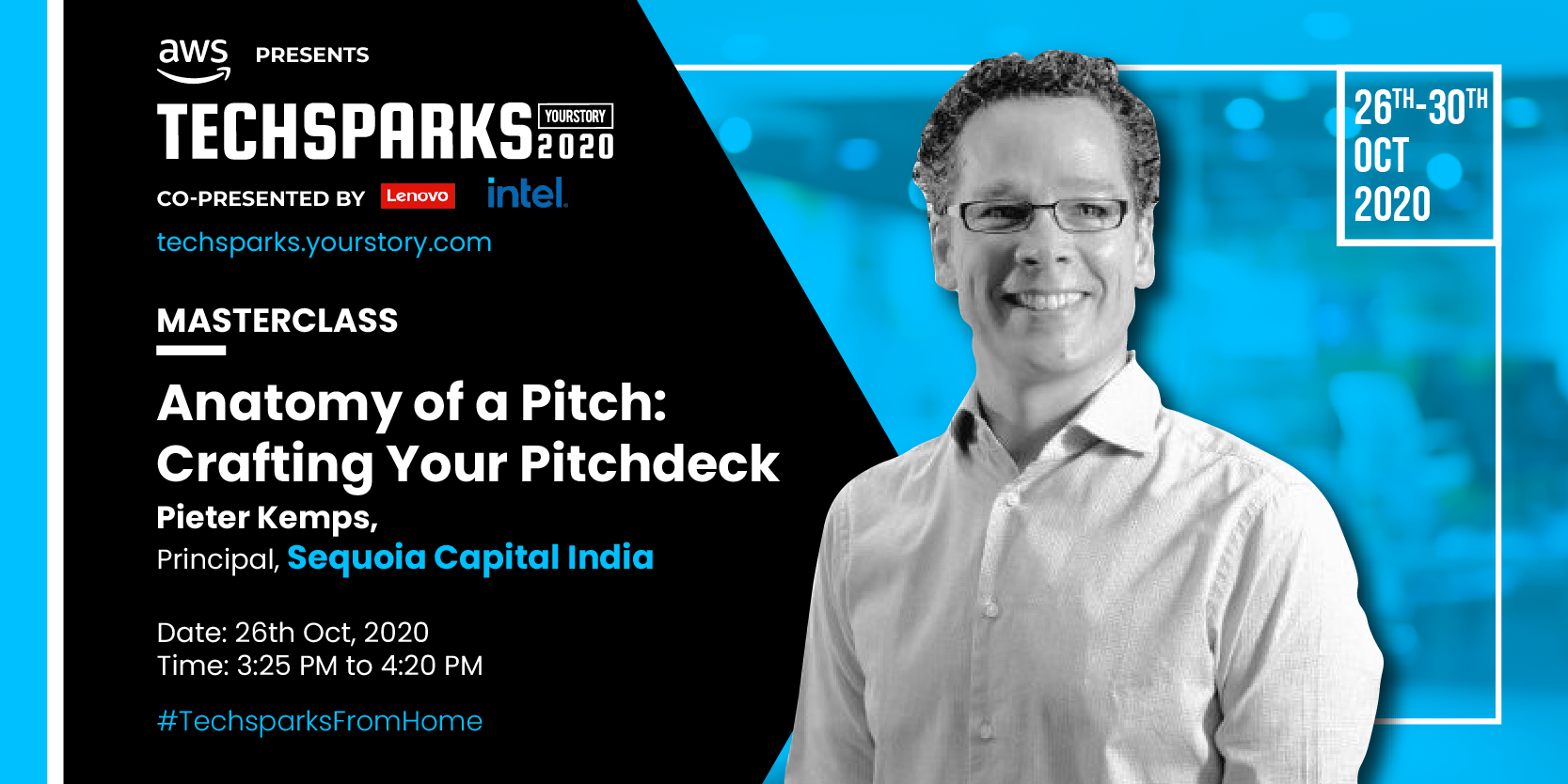The first customer for any startup is effectively a venture capitalist (VC) or an investor. If a founder can successfully pitch his/her startup idea to this community, half the battle is won for them, as what follows is not just capital, but also support, strategy, network, and the list goes on.
However, on many occasions, startup founders often fail the first time in front of prospective investors due to an inadequate pitch deck.
At the 11th edition of YourStory’s flagship event, TechSparks 2020, Pieter Kemps, Principal, Sequoia Capital India, explains this very lucidly in his masterclass session on “Anatomy of a pitch: Crafting your pitchdeck.”
As much as it is important to talk about one’s business idea, market, and customers, Pieter emphasises that the one defining thing about a pitch deck is — “Tell us a story, introduce a tension, and talk about what are things that are changing.”
Importance of comprehension
For startup founders, the pitch deck forms a critical document to make the best impression in front of the VC. But it is important to note what goes into the pitch deck.

Pieter says the pitch deck does not have to be too verbose. At the same time, it should not be light on information as the crucial thing is about unique insights on the startups’ market, customers, and revenue numbers, among other things.
“Try and define your company in a single declarative sentence. It looks simple, but it is very hard,” Pieter says, highlighting the need to use the startup name more often in the document.
As a storied VC investor with offices across the globe, Sequoia Capital has deep experience, knowledge, and insights. At present, it is closely engaging with very early-stage startups through its Surge accelerator programme.
Pieter says the key part of any startup pitch deck is to always talk about the big question — “why?” What are the reasons for a founder to venture out to start a new company?
This should cover topics like how things are changing in the market, what are the pain points of the customers, and what the startup plans to do about it. All of this should tie up to form the bigger picture.
In fact, founders should try to answer how they aim to address the market that is constantly evolving and moving. Pieter says, “The most enduring companies gain dominance because of their unique understanding of market asymmetry or inflection point.”
Customers first
“Always explain how the world is changing and how it is impacting your customer,” Pieter says, adding that the love for customers is one of the critical elements in any startup pitch deck.
Startups need to emphasise the pain points experienced by the customers and the depth to which a founder would go to understand the challenges the users face.
This is a crucial part of the pitch deck as founders need to talk clearly about the product or solution, they plan to bring into the market to solve the customer pain point.
Pieter says showcasing a demo of the product or solution “makes a world of difference” rather than being restricted to a theoretical exercise. Just as a picture is worth a thousand words, Pieter says, “If you show a product demo, it speaks a million words.”
To be different and better
For a startup founder, it is important to talk about the startup’s business model, where one has to demonstrate a competitive edge in terms of how it will create, deliver, and capture value in the market.
He says creating this differentiating edge as a business model is one thing, but building a moat to retain the competitive edge is another aspect for startups. He believes it is better to have one deep moat, where it becomes difficult for other competitors to come in, and other adjacencies to expand this moat can follow through.
He discusses how startups can attract new customers and retain them as well. Highlighting the example of Khatabook, Pieter says the Bengaluru-based fintech startup focused on SMBs acquired over 26,000 merchants within a month of its product launch.
The startup pitch deck is not about a single individual and needs to provide the confidence to the VC community that there is a team, which is going to back this venture.
Founders also need to avoid talking about valuation on their pitch deck as it is a part of the market discovery process, which comes later on in the startup journey. The core focus, Pieter says, should be on “How are you different, and not just better.”
While the founder starts the pitching process, it is important to visualise the future as well.
“Write an e-mail to your future self now. Celebrate the fabulous success you will have achieved five years from now,” Pieter concludes.
For more information on TechSparks 2020, check out our TechSparks 2020 website. Sign up here to join the event.
TechSparks - YourStory's annual flagship event - has been India's largest and most important technology, innovation, and entrepreneurship summit for over a decade, bringing together entrepreneurs, policymakers, technologists, investors, mentors, and business leaders for stories, conversations, collaborations, and connections that matter. As TechSparks 2020 goes all virtual and global in its 11th edition, we want to thank you for the tremendous support we've received from all of you throughout our journey and give a huge shoutout to our sponsors of TechSparks 2020.
Edited by Suman Singh
Link : https://yourstory.com/2020/10/techsparks-2020-creating-startup-pitch-deck-sequioa-capital-india
Author :- Thimmaya Poojary ( )
October 29, 2020 at 07:45AM
YourStory



